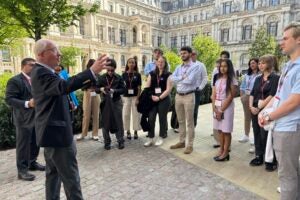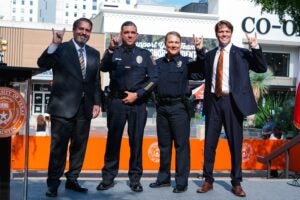AUSTIN, Texas—Scientists at The University of Texas at Austin have received more than $1 million from the Department of Energy to establish a center for studying and manipulating the interactions of a high-intensity laser with matter.
The Texas Center for High-Intensity Laser Science is being established with funds from the Energy Department’s National Nuclear Security Administration (NNSA). The support will allow the university’s Physics Department in the College of Natural Sciences to begin building a high-intensity laser while pursuing high-field laser research with similar, smaller-scale lasers.
The NNSA provided $772,000 in construction funds to the university this year, and $199,000 to Lawrence Livermore National Laboratory to assist with construction. The Physics Department will receive an additional $98,485 in 2003 for high-intensity laser research. The NNSA also has earmarked more than $1.9 million in additional center research funding, to be given out in $400,000 to $500,000 increments over the following four years.
The university is one of only a handful of places nationally that are constructing high-intensity lasers, which open the door to new experiments in physics, chemistry and other fields. The university’s petawatt laser, whose construction may be completed in three years, will produce a short burst of laser light with 2,000 times the power output of the national electric grid, but for exceedingly short time-frames (100 femtoseconds, or 0.000,000,000,000,100 seconds).
Petawatt lasers are expected to be used for many purposes: accelerating electrons to near the speed of light, producing pressures that briefly mimic supernovae, nuclear and other explosions, and generating ultrafast X-rays that can image split-second movements, such as the folding of molecules.
At the university, the petawatt laser will be used for projects that include:
- Dr. Michael Downer’s physics work to better understand the high-speed acceleration of electrons generated when the laser is aimed at an ionized gas called a plasma.
- Dr. Todd Ditmire’s and others’ studies of the microscopic responses of materials to high pressure shock waves or intense irradiation by ultrafast bursts of X-rays. The effort involves fellow physicist Michael Marder, mechanical engineer Eric. M. Taleff (College of Engineering), and Research Scientist Stephan Bless from the university’s Institute for Advanced Technology.
- Physicists Ditmire, Downer, and colleagues Dr. Roger Bentson’s and Dr. John W. Keto’s research on the properties of ionized matter heated to temperatures of up to 10 million degrees Celsius and pressures reaching more than 1 billion times that of Earth’s atmosphere.
- Dr. Ditmire’s efforts to create exploding plasmas that may mimic some features of supernovae, and to create matter/antimatter plasmas postulated by collaborator Edison Liang at Rice University to play a role in producing gamma-ray bursts near black holes.
“We could actually start doing physics—here in the lab—to study how supernovae affect the structure of the interstellar medium or to examine the properties of exotic electron-positron plasmas thought to exist near black holes,” said Ditmire, an associate professor of physics who will direct the Texas Center for High-Intensity Laser Science.
The center will also involve collaborators from the university’s Texas Materials Institute, from the Institute for Fusion Studies, the Fusion Research Center and Center for Nonlinear Dynamics in the Physics Department, and from the University of Michigan. The center will collaborate closely with many other institutions, including Sandia National Laboratory and Lawrence Livermore National Laboratory.
The petawatt laser, whose completion is expected to require $7 million more in funding, will be housed in an underground bay near Robert Lee Moore Hall on Speedway. The three-story bay previously contained the Texas Experimental Tokamak (TEXT), a plasma-confining device used by the Physics Department for fusion energy studies. TEXT recently was dismantled and donated to Huazhong University of Science and Technology in Wuhan, China. Renovation of the bay for the petawatt laser will begin this fall.
For more information contact: Barbra Rodriguez, College of Natural Sciences, 512-232-0675.



